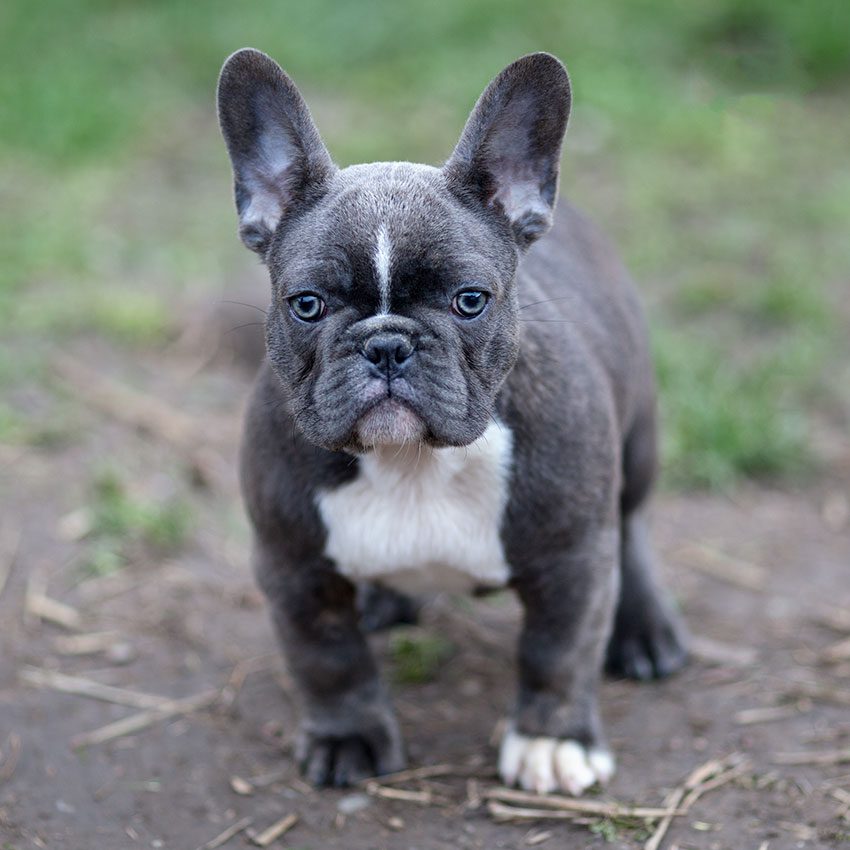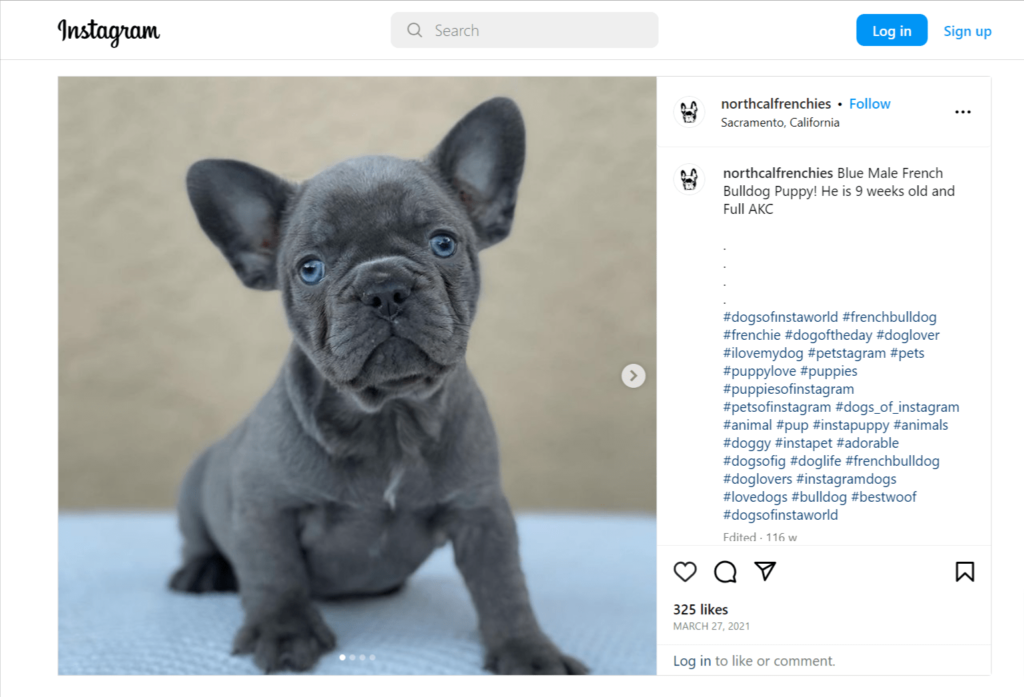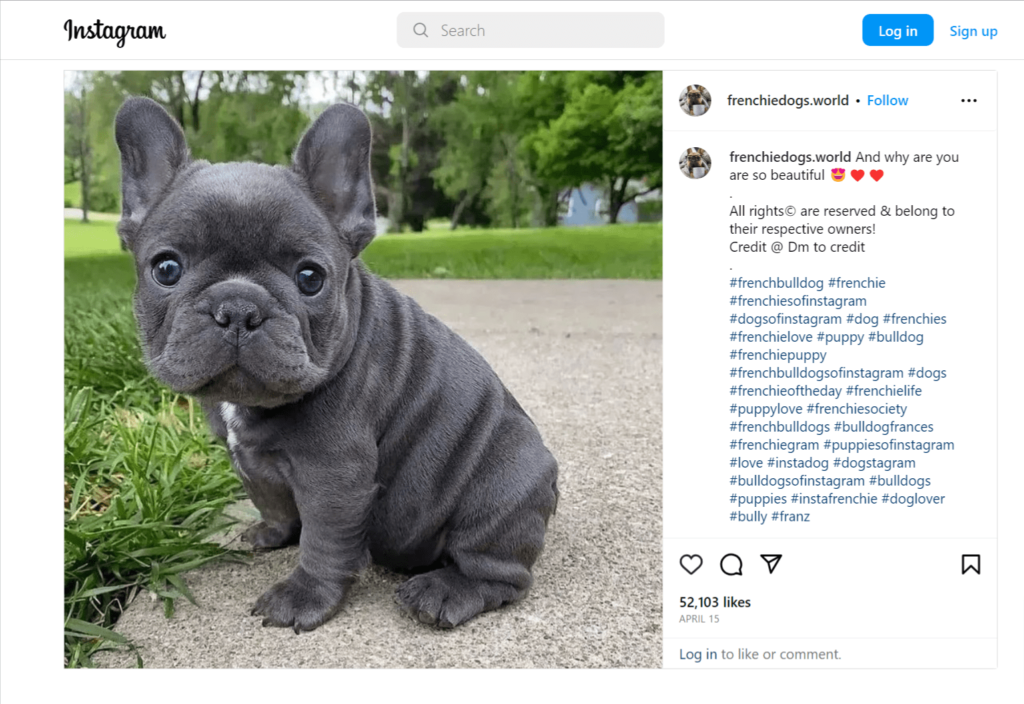With their stunning looks and small sizes, Frenchies are among the most popular dogs in households.
But a Blue French Bulldog is an excellent choice if you want a dog that stands out.
This article will tell you all you need to know about this unique and rare dog.
Come with us.

Are Blue Frenchies actually blue?!
No, Blue Blue Frenchies are not blue but have a grayish-silver color. They have a dilute blackish coat with a blue or grayish appearance. This blue hue can range from light grey to dark steel blue.
What is a Blue French Bulldog?
A Blue Frenchie is a unique color variant for French Bulldogs. This dog comes in a smooth bluish-gray coat that can be entirely solid or patterned with white markings on the chest or belly. This results from a recessive dilution gene that causes the black coat color to fade, giving it a bluish-gray appearance.
Why are they called Blue French Bulldogs?
Blue French Bulldogs are called blue because of their gray coat with an added bluish tint. Additionally, the dilution gene also affects the eyes resulting in blue eyes.
Origin
The Blue French Bulldog shares the same history as the regular French Bulldog. Despite what their name suggests, Frenchies are not from France. These dogs were initially bred in England and were descendants of the British Bulldogs used for bull-baiting and bloody sport.
However, these bulldogs were later left with no work following the banning of bull-baiting in the early 1800s. To save the dogs, breeders cross-bred them with Pugs and Terriers to create smaller versions of the bulldogs.
In the early 1900s, these minute dogs entered France when the lace workers from Nottingham crossed the channel and settled in Normandy during the industrial revolution. The lace workers used them as ratters and companion dogs. The French Bulldog was later brought to America from France, where their popularity quickly rose due to their small size, pleasant temperament, and cuddly personality.
Blue French Bulldogs Genetics
A French Bulldog carries B Locus B / B or B / b and dilute genes d / d (d2). The B locus determines the coat color, which for a Blue Frenchie is originally black. The D locus determines whether a Frenchie is fully colored or diluted.
The D Locus (dilute genes)
It regulates the amount of eumelanin pigment, which is black for Blue Frenchies, and the pigmentation of their eyes and nostrils. This locus has two alleles: D and d. Since eumelanin dilution is a recessive characteristic, only a D /d will be a carrier.
- D is non-dilute, while d is dilute.
- Only dogs with dilute genes d/d are dilute
- Dogs with D / d are carriers and have normal pigmentation.
Why Do Blue French Bulldogs Have A Diluted Coat?
A mutation in the melanophilin gene causes the diluted coat of a Blue French Bulldog. Melanophilin transports and fixes melanin-containing cells. Mutation of the melanophilin gene results in an uneven distribution of cells in the dog’s coat.
7 Fun Facts About The Blue Frenchie
The following are some facts about the Blue French Bulldog that you may not know:
- They are among the most popular dogs: French Bulldogs have been ranked 4th most popular dog breed in 2018, according to the AKC. This makes the rare Blue Frenchie among the most popular dogs worldwide.
- Blue Frenchies are not really French: Despite what their name suggests, Frenchies are not from France. Rather, they are English, as their origin can be traced to an area in England in the 1800s. It’s not exactly known where their name came from.
- Celebrities love the Blue Frenchies: It’s obvious that celebrities love this adorable dog. From actresses including Eva Longoria and Reese Witherspoon to pop stars like Madonna, celebrities love their blue canine friends. But who wouldn’t? Blue Frenchies are naturally charming.
- They cannot give birth naturally: Blue Frenchies, like their non-blue counterparts, have large heads and compact bodies. This makes it extremely difficult for these dogs to give birth naturally. They require a caesarian section to give birth safely. Any attempt by these dogs to give birth naturally may result in health issues afterward. Many breeders take extra care with these and schedule a C-section in advance, making it difficult to find a Blue French Bulldog born naturally.
- Blue Frenchies can’t swim: Frenchies are not good swimmers, unlike other dogs. Their body structures consist of a big head and short legs. They are also flat-faced and thus prone to breathing issues. This makes it highly likely for Blue Frenchies to sink into the water quickly. Although they may paddle a bit, they can’t hold on for long due to their weight. Get a life jacket for your Frenchie if you are near water.
- Their blue coat results from a recessive gene: A blue French Bulldog’s coat results from a recessive dilution gene in this dog. This gene causes the black base color of Frenchie’s coat to fade, giving it a bluish-gray appearance.
Are Blue French Bulldogs Purebred?

Yes, Blue French Bulldogs are pure-bred dogs as they are just a color variation within the pure French Bulldog breed. It requires very particular genetics to achieve this unique color. The only way to pass on the coat color to puppies is by breeding two purebred Blue French Bulldogs.
However, being purebred is not an assurance that they will be accepted. Unfortunately, the AKC does not recognize the Blue French Bulldog despite all the efforts that go into breeding them.
Why are Blue French Bulldogs disqualified?
The blue coat color of French Bulldogs is disqualified as the official breed standard does not recognize it. It is regarded as a trendy color and thus is disqualified from upholding the breed standard and safeguarding the efforts of responsible breeders who follow the breed standard.
Blue and other trendy hues usually fetch high prices on the market. As such, many breeders are driven by greed to breed such colors. These breeders deliberately introduce unacceptable color genes into the gene pool, which poses issues for respectable breeds that strive to produce high-quality French Bulldog puppies.
Personality and Temperament

Blue French Bulldogs are extremely affectionate and friendly dogs that make excellent companions. They are incredibly loyal to their owners and love to always stick around them. Blue Frenchies are called Velcro dogs due to their clingy nature to their owners and family. This means they don’t handle being left alone for long durations as they may suffer from separation anxiety.
Blue Frenchies have a charming and laid-back personality. They are highly sociable and get along well with everyone, including strangers. Blue Frenchies are quiet dogs and will not bark without a good reason. This low barking tendency makes them good apartment dogs. Although they are low barkers, Blue Frenchies snore loudly.
Blue French Bulldogs are also highly adaptable. They easily get used to any situation. However, they can be quite territorial, making it a little hard to get along with other pets and dogs. These dogs love children and get along well with them. However, Blue Frenchies are very fragile and may not be a good choice for small children who have not been taught how to handle them.
These dogs are also quite lazy and would rather cuddle with you in bed. They are not high-energy dogs and don’t need a lot of exercise to remain fit and healthy. However, they still need some exercise, like short daily walks, to burn off extra energy and avoid destructive behavior.
| Temperament | Loving, friendly, loyal, charming, and laid-back |
| Exercise needs | Low |
| Adaptability | Highly adaptable, can easily cope with all situations |
| Relationship with kids | Good, gets along with children |
| Relationship with other dogs and pets | Good, gets along well with other pets and dogs if well socialized. |
| Barking tendencies | Low |
| Trainability | Easy to train |
Blue French Bulldog Appearance
Blue Frenchies are small, short, and stocky dogs marked by a smushed-in, heavily wrinkled face and distinctive bat-like ears that are pointed and attentive to the surrounding.
Like any other Frenchie, Blue Frenchies stand between 11-13 inches tall and weigh between 16-28 pounds. These Frenchies have a short gait, scrunchy noses, and a short stumpy tail that is not docked.
A Blue Frenchie has a loose, soft, silky, and shiny coat that comes in a distinctive bluish-gray and can either be solid or with some white patches on the chest and belly. The fur is short and straight, giving them a sleek look and making it very easy to groom.
Unlike other Frenchies with dark, almost black eyes, Blue Frenchies have light blue, gray, or green eyes and a blue nose.
| Height | 11-13 inches |
| Weight | 16-28 pounds |
| Coat type | Short, silky, and shiny |
| Coat color | Bluish-gray |
| Eye color | Blue, gray, or green |
| Tail | Short and stumpy |
| Legs | Short and stocky |
What are the different Blue French Bulldog Variations?
The Blue French Bulldog has four different color variations as follows:
Blue
Blue Frenchies have a grayish-blue coat that can be with or without white patches on the neck and belly.
- Blue Fawn
Blue Fawn Frenchies have the dilute gene as well as a brindle gene. These dogs come in a cloudy-like color. A Blue Fawn Frenchie has a fawn coat with a blue mask over the ears and face. This means this dog’s body is fawn while the face and ears are blue.
- Blue Merle
Blue Merle Frenchies have a blue coat with markings that don’t follow any particular pattern. The coat is light blue with darker strips, spots, and swirls. They also have blue eyes that they maintain throughout their entire lives.
- Blue Pied
The Blue pied Frenchies have a coat with white as the base color with patches of blue. You bred a white (pied) Frenchie with a solid blue French Bulldog to get a Blue Pied French Bulldog. The color intensity and size of the patches on these dogs differ from one dog to the other. Blue pied Frenchies
- Blue Sable
A Blue Sable Frenchie has blue-tipped hair and a blue mask instead of black. These dogs have a fawn coloration on the head and lower legs, but instead of having black-tipped hairs on the body and a black mask, they have beautiful blue-tipped hairs with a blue mask.
- Blue & Tan
Blue and Tan Frenchies have a solid blue base color with beige markings on their paws, chest, bottom, cheek, and eyebrows, making them extremely unique and rare.
Blue French Bulldog Size

How big do Blue French Bulldogs get?
A fully grown Blue French Bulldog stands between 11-12 inches in height and weighs between 16-24 pounds for females and 20-28 pounds for males.
Life Span
How Long Do Blue French Bulldogs Live?
The life span of Blue French Bulldogs is influenced by factors such as diet, genetics, lifestyle, and activity level. However, a French Bulldog generally has an expected life span of 9-12 years. Sadly, Frenchies are prone to various health disorders that shorten their lifetime and lower their quality of life, and Blue-French Bulldogs are more prone to health problems than other colors.
Blue French Bulldog Eye Color
Blue Frenchies have bright-colored eyes that make them different from other dogs.
Do Blue French Bulldogs Have Blue Eyes?
Yes, Blue Frenchies have blue eyes that can be light blue, bright blue, or dark grayish blue.
Do Blue French Bulldogs Have Green Eyes?
Yes, some Blue French Bulldogs have green eyes, although they are less common than blue eyes. Green eyes are more common in Isabella/ Lilac French Bulldogs.
What Are the Specific Health Issues Linked to the Blue French Bulldog?
All French Bulldogs, irrespective of color, are prone to various health issues. However, Blue Frenchies are more prone to different health issues. The following are some of the issues that are specific to Blue Frenchies.
Minor Health Conditions
- Conjunctivitis
- Cherry eye
- Hypothyroidism
- Cataracts
- Atopic dermatitis
- Distichiasis
- Retinal dysplasia
- Pulmonic stenosis
Major Health Conditions
- Color Dilution Alopecia: Blue Frenchies are particularly prone to a hereditary skin condition called color dilution alopecia or CDA. This condition causes hair thinning, loss, and dry, flaky, and itchy skin.
- Allergies: Blue Frenchies, just like other Frenchies, are prone to allergies. A Frenchie with allergies will exhibit itchy skin, runny nose, sneezing, constant scratching, and paw licking.
- Spine malformations include hemivertebrae, intervertebral disc disease, and degenerative myelopathy.
- Brachycephalic airway syndrome refers to a particular set of upper airway abnormalities, such as elongated soft palate, stenotic nares, and laryngeal collapse. This results in respiratory and breathing problems in Blue Frenchies
Shedding, Skin Problems & Hypoallergenic Facts
Are Blue French Bulldogs Hypoallergenic?
No, Blue Frenchies are not hypoallergenic. Although they are not known for heavy shedding, these dogs have short coats that shed moderately and produce a significant amount of dander which irritates people with allergies. In addition, Blue Frenchies are prone to color dilution alopecia which causes dry and flaky skin making them even more unideal for allergy patients.
Do Blue French Bulldogs Shed?
Yes, Blue French Bulldogs shed moderately. However, you can reduce shedding by brushing their coats weekly with a soft brush. You should also bathe your Blue Frenchie every 1-2 months to remove loose hair and minimize shedding.
Do Blue French Bulldogs Have Skin Problems?
Yes, Blue Frenchies have skin problems. They are prone to a skin condition called color dilution alopecia which causes dry, flaky skin and hair thinning and loss. This skin problem develops between 4 months and 2 years of age.
How To Care For A Blue French Bulldog

Diet
Frenchies are prone to weight gain. It’s thus crucial to be careful about their diet, specifically the quality and amount of food they take. Given their small size, Frenchies have a fast metabolism and need more calories per pound of weight than large dogs. Additionally, Blue Frenchies are lazy dogs with low energy levels and low exercise needs. This further increases the risk of unhealthy weight gain and obesity.
Blue Frenchies require a diet formulated for small breed dogs, designed to make it easier for them to pick up their food and encourage chewing. A French Bulldog’s diet should consist of high-quality real animal proteins. These dogs should be given up to 2 cups of high-quality food divided into 2 portions.
What To Look For When Selecting Food
- These are some of the things you should look out for when selecting food for Blue Frenchies:
- It should be complete and nutritionally balanced
- The food should include high-quality, lean animal proteins from sources such as chicken and fish.
- It should contain moderate calorie levels
- It should be free from any fillers, additives, or artificial ingredients
- The food should include healthy sources of omega-3 fats
Read our article on 10 Best Foods for French Bulldogs
Avoiding Skin Issues
Since Blue Frenchies are particularly prone to skin issues, ensuring their diet has appropriate omega 3 &6 levels is important to promote healthy skin. You should also avoid giving them table scraps and minimize treats.
Read our article on 10 Best Dog Food for Frenchies with Allergies: What to Choose
Exercise
French Bulldogs are low-energy dogs. As such, they do not require a lot of exercise to keep them fit. Giving them at least one hour of low-intensity exercises is recommended to avoid causing them breathing issues. Being a brachycephalic dog, over-exertion can easily lead to breathing difficulties in Blue French Bulldogs.
Short, low-intensity daily walks usually do the trick for these dogs. You can break the one hour of exercise into 2 daily walks. You can also allow your dog to play off lead. You’ll also need to keep your Blue Frenchie mentally stimulated to keep them from being bored and engaging in destructive behavior. Interactive toys and puzzle toys are excellent ways of keeping Frenchies mentally occupied.
Read more on How To Walk A French Bulldog: Everything You Should Know
Grooming
Blue Frenchies have short coats that are very easy to maintain. These dogs only need weekly coat brushing to keep their coats in top condition.
Brushing
Blue Frenchies need weekly brushing to help remove loose hairs and keep the coat shiny and healthy. Since they have a short, silky coat, you should use a soft grooming brush to brush a Frenchie’s coat. Regular brushing will also keep the hair off your floor.
Bathing
It’s recommended to bathe your French Bulldog dog every once or twice a month or whenever necessary to keep them clean. Frequently bathing your dog can eliminate all the essential body oils resulting in a dry coat and flaky skin.
You should also ensure you use dog shampoo for bathing your dog. Opt for a hypoallergenic shampoo if your dog has sensitive skin. Remember to thoroughly clean the skin folds and flaps and keep them dry to avoid infections.
Read more on How To Bathe A French Bulldog Puppy + BATHING PRODUCTS
Training
While Blue Frenchies are intelligent dogs, they can also be quite stubborn, making training them challenging. It’s thus important to start training these dogs as early as possible, ideally when they are about eight (8) weeks of age.
Frenchies don’t handle criticism well. As such, the best way to train them is by using positive reinforcement techniques. You can use treats to motivate them. Training for Frenchies includes potty, obedience, crate, and socialization training.
Potty Training
Potty training your Blue Frenchie is not an easy task. However, you can use the following tips to make it easier:
- Take your dog outside to the area you want them to go
- Tell your Frenchie to ‘’go potty’’ while at the spot
- Give it some time to pee or poop
- Reward them with a treat once they are done
- Ensure you always take your Blue Frenchie out 5-10 minutes after feeding them.
- Repeat the process until your Frenchie learns to use the potty independently.
Read more on How To Potty Train Your French Bulldog (The Ultimate Guide)
Crate training
The following tips can make crate training your Blue French easier:
- Familiarize your Blue Frenchie with the crate. Allow it to sniff and walk around it.
- Persuade the dog to enter the crate. You can motivate it using treats
- Keep the crate’s door open and allow the Frenchie to get accustomed to it.
- Attempt closing the crate door and reward your Frenchie with treats
- Work on closing the crate for longer durations of time, then leave the room and return
- Gradually extend the time the Frenchie spends in the crate until it’s at ease with being in it for longer periods.
Male vs. Female Blue French Bulldog
There are significant differences between a male and a female Blue French Bulldog. The only difference is that a female Frenchie weighs slightly less (16-23 pounds) than a male Frenchie. Your choice is thus purely a matter of personal preference.
Blue French Bulldog Coat Color Statements by Kennel Clubs Worldwide
The following are some of what kennel clubs worldwide say about the Blue French Bulldog coat color:
- New Zealand Kennel Club: ‘’ Very serious Faults: Colour of coat black and tan, mouse grey, brown’’.
- Canadian Kennel Club: Disqualifications…black and white, black and tan, liver, mouse or solid black’’.
- The Kennel Club (UK): ‘’Tan, mouse and grey/blue highly undesirable’’.
- Australian National Kennel Council: ‘’Tan, mouse, and grey/blue highly undesirable.
- Federation Cynologique Internationale (FCI): ‘’Disqualification: Color coat black and tan, mouse grey, brown’’.
Note: The blue coat is also referred to as ‘’mouse’’ or ‘’mouse gray’’.
Can You Show Blue French Bulldogs?
No, you can’t show a Blue French Bulldog since its coat color automatically disqualifies it. The goal of showing is for judges to determine how closely each dog resembles the ‘’ideal’’ French Bulldog outlined in the breed’s official standards.
Why are Blue French Bulldogs so expensive?
The main reason why Blue Frenchies are very expensive is because of their inability to give birth naturally. They require artificial insemination and a caesarian section to give birth, which are expensive procedures. In addition to their small litter size, the blue coat color is rare. Generally, the rarer the color, the more expensive the dog.
The Cost of Owning A Blue French Bulldog
Owning a Blue French Bulldog is a costly affair. Besides the high acquisition price, Blue Frenchies are prone to various health issues, which may turn costly in terms of veterinary costs. The frequent veterinary care and the multiple vaccinations these dogs require can quickly accumulate to high costs.
You’ll also need to incur other costs for other supplies such as toys, leash and collar, harness, bed, warm clothes, grooming supplies, and food. To make the costs more manageable, getting insurance for your Frenchie is advisable.
Do blue Frenchies have health problems?
Yes, unfortunately, Blue Frenchies are more prone to several health problems. These dogs are particularly prone to color dilution alopecia (ADC), a skin condition that results in hair thinning and loss and flaky, dry, and itchy skin.
Like other brachycephalic dogs, Blue Frenchies are prone to breathing issues. Other health problems in Blue Frenchies include spine deformities, allergies, and eye and ear infections.
How rare are blue Frenchies?
Blue Frenchies are among the rarest dogs in the world. The color dilution gene resulting in the blue coat color is rare. This makes Blue French Bulldogs very expensive.
What’s The Difference Between Lilac and Blue Frenchie?
Compared to Blue Frenchies, Lilac Frenchies have a significantly lighter coat which gets even lighter as they age while maintaining their characteristic lilac color. A blue French Bulldog is a diluted black coat, while a Lilac Frenchie is a diluted chocolate coat. Besides color, there are also several differences between these two Frenchies, as summarized in the table below:
| Difference | Lilac French Bulldog | Blue French Bulldog |
| Height | 10-12 inches | 10-13 inches |
| Weight | Up to 20 pounds | Up to 28 pounds |
| Color | Purplish gray, Lilac | Bluish Gray |
| Coat type | Short and fine | Short and dense |
| Life expectancy | Up to 12 years | Up to 15 years |
| Temperament | Playful, affectionate, and laid-back | Friendly, relaxed, easily agitated |
| Health | Average health | Most prone to health issues among the whole Bulldog breed |
How does the Blue French Bulldog get its unique coloring?
The unique blue color in Blue Frenchies results from a recessive dilution gene that alters the coat color of Frenchies from black to grayish-blue. This gene also causes a change in their eye color.
What are the different variations of Blue French Bulldogs?
The Blue French Bulldog comes in several color variations, including blue merle, blue fawn, blue pied, blue brindled, blue sable, and blue and tan French Bulldogs.
What are the specific health issues linked to Blue French Bulldogs?
Blue French Bulldogs are specifically prone to a condition called color dilution alopecia. This causes hair thinning and loss, resulting in dry, itchy, and flaky skin in these dogs. They are also prone to breathing issues due to their brachycephalic nature.
Should you get Blue French Bulldogs for your family?
A Blue Frenchie will be a good fit for your family if you live in an apartment and looking for a small dog that doesn’t need a lot of exercise. It’s also a good choice if you want a companion dog that will always be by your side.
Does the AKC recognize Blue French Bulldogs?
No, the AKC does not recognize Blue Frenchies as an official French Bulldog color.
Colors officially recognized by the AKC.
The AKC officially recognizes 8 colors for the French Bulldog, including white, fawn, cream, brindle, fawn and white, white & brindle, fawn brindle, and fawn brindle & white.
Read more on Standard and Exotic French Bulldogs Colors Explained + PRICE BREAKDOWN.
How can you register a Blue French Bulldog with the AKC
Presently, it’s not possible to register a Blue French Bulldog with the AKC as it does not meet the breed standards.
The AKC has strict breed standards.
Blue is not among the 8 AKC-approved colors for the French Bulldog breed and, thus, does not meet the club’s breed standards for Frenchies.
Can Blue French Bulldogs Change Color?
No, Blue French Bulldogs don’t change the color of their coats. The only change can occur when they are puppies, whereby their coat may lighten. A Blue Frenchie puppy may appear black at birth but gradually become blue over the following weeks.
Are Blue French Bulldogs Unhealthy?
Dogs with the color dilution gene, like Blue French Bulldogs, have a higher risk of getting health issues. One is color dilution alopecia, a genetically inherited disorder that results in hair thinning and loss and flaky and itchy skin.
Are Blue French Bulldogs Rare?
Yes, Blue French Bulldogs are among the rarest dogs there are. The dilute gene that causes their unique coloration is relatively rare. The Blue Merle Frenchie is the rarer variation of the Blue French Bulldog.
Blue French Bulldogs Names
The following are the most popular names for Blue French Bulldogs:
- Misty
- Cinder
- Slate
- Lili
- Gris
- Ash
- Bailey
- Billie
- Teal
- Winter
Blue French Bulldog Buyer’s Guide
The following are the pros and cons of the Blue French Bulldog that you should consider before getting one:
Pros
- Blue Frenchies are easy to groom: Generally, Frenchies have a short, straight, silky, and shiny coat that sheds minimally. Typically, Blue French Bulldogs shed twice a year. This makes them very easy to groom. Regular coat brushing is all you need to keep the dog’s coat in good condition.
- They don’t require a lot of exercise: Blue Frenchies have low-energy dogs that don’t need lots of exercises to remain healthy and fit. This is beneficial, especially if your schedule is tight. They only need short daily walks to keep them active.
- They are small-sized: Frenchies are minute dogs that don’t need much space. This makes them perfect apartment dogs.
- They have low barking tendencies: Blue Frenchies, just like the other non-blue Frenchies, are calm and quiet dogs that hardly bark without a reason. They will only bark to notify you of strangers or unfamiliar situations.
- They are extremely stunning dogs: Blue Frenchies come in a unique blue-colored coat and blue, green, or grey eyes, making them stand out from other dogs.
Cons
- They are expensive: Blue Frenchies are difficult to come by, which makes them more expensive than other dogs.
- They are prone to several health issues: French Bulldogs are prone to many genetic disorders due to their genetic makeup. Blue Frenchies have a higher risk of having these health issues.
- They cannot regulate their body temperatures: Blue French Bulldogs are brachycephalic dogs. Due to their short snouts and narrow nostrils, these dogs cannot regulate their body temperatures and thus can’t cope in hot/warm climates.
What is the lifespan of a blue French Bulldog?
Although this depends on the kind of diet and level of exercise, a blue Frenchie can live for up to 12 years.
Summary
Blue French Bulldogs are not only spectacular but also make excellent companions. These dogs have friendly and laid-back personality that makes them irresistible to many people. However, Blue Frenchies have a higher risk of various health issues. They are also highly expensive to acquire and maintain. The following table gives a summary of this dog breed.
Breed Summary Table
| Blue French Bulldog characteristic | |
| Height | 11-12 inches |
| Weight | 16-28 pounds |
| Lifespan | 10-12 years |
| Temperament | Playful, friendly, and affectionate |
| Exercise needs | Does not need a lot of exercises. Requires a minimum of 1 hour of exercise daily at low intensity. |
| Coat type | Smooth, flat, and shiny |
| Shedding level | Low to moderate |
| Activity level | Low |
| Adaptability | Highly adaptable, perfect for apartment living |
| Relationship with children | Good with children |
| Coat color | Grayish- blue |


